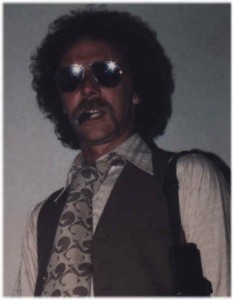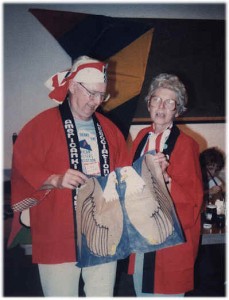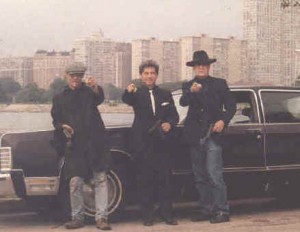 So, here we go again! Has a month passed already? I’m not sure about the rest of you, but when the spring and summer kiting season begins, time just seems to fly by.
So, here we go again! Has a month passed already? I’m not sure about the rest of you, but when the spring and summer kiting season begins, time just seems to fly by.
Most exciting news since last Tangents is the reunion I had with Charlie Moore after about 10 years. Strangest part of finally getting together with Charlie is that he did not look me up because of Chapter One of Tangents and Trivia. Charlie had not seen KITELIFE at all until after I talked to him. Seems that because so many of us had Charlie Moore in mind he some how knew and contacted me through online friend Gizmo Gerwick, prez of the Black Swamp Air Force Kite Club here in Ohio. Wow! Forget about the power of the computer, the power of the mind wins this time.
We will be hearing more from Charlie in the future. Charlie now lives in Colorado and if you can believe this, the Izuzu Trooper that Charlie was pictured in — see Tangents, Chapter One — is still in Charlie’s driveway. (With 230,000 miles on it. Seems that a lot of people hold onto old “stuff” like me!)
Just finished a trip to Ocean City Maryland and the Maryland International Kite Festival, and the Great Lakes Sport Kite Championships in Grand Haven, Michigan. Great festivals, and I had a good time, despite a few pot holes that my team, Shanti Air, fell into. I have always enjoyed these festivals. There are lots of very committed and enthusiastic kitefliers at these events. (BUT I HATE SAND and the HOURS AND HOURS OF DRIVING) The adventures in Maryland and Michigan in 1998 will probably not be written about in TANGENTS AND TRIVIA until Chapter 55 or 60 so “Don’t touch that Dial. . . . . .?”
“OK SHERMAN, LET’S SET THE WAY BACK MACHINE FOR 1981…”
CHAPTER THREE – THE CHICAGO MOB
The best thing about Chicago in the 80’s was the huge mix of people that lived there. Population for the Windy in 1980 was right around 3,500,000 people. The big disadvantage to this size of city is possibly 10 -15,000 people may have been into kiteflying, just like me but I would never see or hear of them. I always have to laugh when someone from somewhere else, upon hearing that I was from Chicago would ask, “…Do you know so and so; they live in Chicago, too?” Yeah Right! The average person that lives there may come into contact with one tenth of one percent of the total.
In 1980 Brother Tom, Al Meyer and I were pretty regular kiters. By this time we had infected many of our other friends and fellow hobbyists. Al Meyer arrived at our local flying field one day with the latest copy of KITE LINES (Our Bible at the time!) In the classified ads in the back was a little ad that read “Kitefliers in Chicago interested in starting a kite club, contact Lee and Anita Hoover. Phone #- – – – – –.”
The three of us left the field immediately and called the Hoovers. Anita Hoover answered and said that they would be glad to meet with us at Horner Park, a field close to everyone’s house and almost right across the street from Lee and Anita’s place. To give those of you that have never been to Chicago a perspective of where we were in Chicago. Horner Park is not Inner City Chicago. It is about 8 miles from the Lake to the East and 8 miles from the citie’s Western boundary. Just about mid-city.
We met Lee and Anita at the arranged place and time. Lee and Anita were in their 60’s and two of the nicest people that I had ever met. Lee Hoover was already retired and Anita was planning retirement in the next year or two.
Lee and Anita had received several replies to their ad in KITELINES from fliers other than Al, Tom and I. Anita suggested that we all meet at their house the next weekend to discuss plans for forming a club in Chicago. In March of,1981 a group of kiters consisting of Al Meyer, Lee and Anita Hoover, Charlie and Pat Sotich, Tom Lach, Brother Tom, Mike Steele and Joe Scaccanocie and I met at Lee and Anita’s. We discussed many things about what we wanted a kite club to be and what direction and activities we wanted to take.
WHAT’S IN A NAME?
The biggest task we started out with was to choose a name for the new club. Everyone wanted Chicago to be part of the name. Anita suggested that because some of the original members were not residents of Chicago, we should not buttonhole ourselves with a “Chicago only” handle. And what was Chicago most famous for? The downtown Sky Line, of course. So the name became the “Chicagoland Sky Liners”
To give you a small example of how complicated “organization” can really be. When the new group decided that they should vote on the new name, there was a two hour discussion on whether the word Sky Liners should be one word or two. (As you can see I am one of the two word faction!) To this day about half the current club writes it one way the rest the other. DON’T OVER ORGANIZE. Remember it is all really only just kiteflying.
The newsletter became known as “Sky Lines” and was destined to become one of the most popular, well produced (and silliest) kite club newsletters of the 80’s.
CLUB OFFICERS, DUES AND BY-LAW
Someone has to “lead” any organization. This includes a kite club. Lee Hoover volunteered to be the club’s first President and Anita Hoover would become the secretary and treasurer. I volunteered to be Lee Hoover’s vice president.. Anita had already drawn up a list of “By-laws” that would suggest possible duties of these officers, their terms of office and their process of election.
These “by-laws were contained on a single sheet of paper. They were very simple and to the point. (Several years ago a kite club in Central Ohio “organized” themselves out of existence with a set of “by-laws that covered 25 pages of very technical “stuff”. More on that organization in a future TANGENTS AND TRIVIA.)
We agreed that we would create and publish a newsletter six times a year; this would initially be Anita’s task. We also agreed to collect a yearly dues to cover the expenses of the newsletter and the basic operation of the club.
Dues can be a difficult topic of discussion for kitefliers. What will the expenses be if you really have not incurred any yet? Who takes care of them? What will they be used for in the future? These areas should all be discussed in the beginning.
The best person for a position as an officer in a kite club would be the one that simply “volunteers”. It also helps to have a strong personality and lots of energy. The biggest single thing I can suggest for a kite club officer is, upon assuming the duties of an officer, IMMEDIATELY begin to train a replacement. This solves two major problems down the line. First, you aren’t going to be stuck doing this “Job” (Trust me it is a job!) forever and second, you can help determine what direction the club will take after you pass along the reins of power to someone else.
A simple club in the beginning only needs someone to lead (President), someone to help the leader (Vice President), someone to collect dues if you choose to have them. (Treasurer), and someone to lead production of a newsletter (Editor). You can have all or none of these positions, it’s your choice. Just remember to KEEP IT SIMPLE. Over-organization can and does eat kite clubs!.
One thing that I can suggest concerning officers is to “Support Them”. By this I mean that even if the person in charge is not moving in the direction you think is best, support them. When Lee Hoover was the Sky Liners President, there were things that I thought he should be doing and wasn’t. My solution was to help Lee any way I could during his term. I then ran for President and became the “Guy with the Plan”. While I was CSL President, Charlie Sotich was my vice-president. There were things that Charlie didn’t like that I did. He supported me during my term. He then ran for the office of Prez and began to change things his way. Lee and I supported Charlie every way we could, even though we didn’t always agree with Charlie’s direction.
Remember a kite club is kind of like a child. You raise it and teach it in the beginning. At some point in its growth you have to let it go. You have to let it grow on its own and become what it wants, not what you want it to be.
But the most important thing for a beginning kite club to decide on is
A REGULAR FLYING FIELD
Chicago is blessed with a beautiful lakefront, with plenty of parks and open spaces. This is very different from many other cities that border water. San Francisco’s waterfront used to be a very bad neighborhood. (It has since been renovated).Cleveland’s lakefront was not the greatest place in Ohio in the 1980’s. Chicago had this beautiful lakeshore simply because when the Chicago Fire occurred in 1871 the city fathers dumped all the wreckage and burned rubble into the lake and covered it with dirt. Wah Lah! Parks!
The park that the novice Sky Liners choose was on Montrose Avenue and the Lake. Anita and Lee called it “Cricket Hill” because of a very large sledding hill at one corner of about 1/2 mile square grassy park. I don’t think anyone else in Chicago called it “Cricket Hill”, at least no one my age did. In actual fact Lee and Anita said that the hill was actually a garbage dump covered with dirt and grass in the 1940’s. The Sky Liners COULD NOT fly next to a garbage pile, so someone in that beginning club “invented” the story ( and a very elaborate one, I might add) that this hill was the burial site of a P.T. Barnum elephant that died in the 1890’s; the elephant was supposed to have been named “Cricket”
The Sky Liners elected to meet at Cricket Hill on the second Saturday and fourth Sunday of every month all year long. This field became the real “Kitefliers Meeting Place” in Chicago. Many newcomers heard of the field and joined the club just because they knew where we would be flying regularly.
As the Sky Liners increased in numbers and location the club moved one of the monthly flies to a field in the suburbs. Ned Brown Woods is a huge field and preserve about 20 miles from the lakefront. This field was the site of the Chicago Sport Kite Championships of the 90’s. It was the field where the Sky Liners flew the famous 105 Flexifoil World Record stunt kite train, the “Chicago Hook and Ladder” .
Success can jump up and bite you at times. In the early 1990’s the Sky Liners had to move both monthly kite flies to Ned Brown Woods because several hundred non-Sky Liners would be flying at Cricket Hill on weekends and there was no where for the club to fly. We had told everyone that Cricket Hill was the best place to fly kites!
ADVERTISING AND SUCCESS
Another area that can really help a kite club to grow is handouts and printed literature. (This is something that I am familiar with as my “real life” job is graphic arts and printing) The Sky Liners had a membership brochure that they distributed in HUGE numbers to anyone that was interested. The handout had a membership application, and a short description of who we were, what we did and where we flew. CSL must have passed out thousands of these simple handouts. Even if the person that you gave it to wasn’t interested, maybe “Uncle Harry” would see the handout and become interested. Some of us actually walked around the Cricket Hill parking lot during our regular kite flies and passed out literature to people that were sitting in their cars watching. PROMOTE YOUR KITE CLUB
CLUB FUND RAISING
Along with these field handouts, the Sky Liners promoted children’s kite making classes. This is an excellent way to raise funds for the club. It is a very good way to acquire new members. Most often, that new member will be one of the parents of a child the club instructs on making kites. There are many excellent beginner’s workshop kites to choose from. (Many have plans listed on the internet). One major item to remember is that only a certain few members will actually be able to teach many of the kite making workshops. Many classes will be for school students, and these classes will be scheduled during the week and in the daytime. Retired members and members that work the night shift are a good choice. Please remember that even though these kite workshop teachers are volunteers, they should be reimbursed for any personal expenses they might incur (travel, materials, etc.) The Sky Liners have taught tens of thousands of Chicago kids to make kites, and filled their kite kitty with well earned funds. They have also diligently promoted kiteflying to young and old alike throughout the years. Much of this promotion has been through kite making workshops.
Kite auctions and kite swap meets are also a great way to increase club funds. Remember to keep it all kite related as that is what everyone should have joined the club for in the first place.
KITEFLYING IS WHAT A KITE CLUB IS ALL ABOUT
The most important single thing I can say about forming a kite club is to make sure that everything you do is ABOUT KITEFLYING. Hold many of your business meetings ON THE FLYING FIELD. If there are decisions to be made, they frequently can be made in the best interests of a kite club ON THE FLYING FIELD. When members loose track of what attracted them to the hobby and the sport in the first place this is the first step toward the downfall of a kite club. Many people join kite clubs to get away from business, stress and pressure. Just remember, “It’s only Kiteflying”
HOSTING A KITE FESTIVAL
Another way to promote kiteflying and your kite club is by hosting a kite festival. These festivals are great fun and your club can control the way the festival is run. (See Chapter Two of Tangents and Trivia for the bad experiences that can happen when non-kiters run kite festivals.)
(I have started to realize that an internet magazine, like this one, really don’t have the size restrains that a printed magazine does, SO before I get out of hand…)
In Chapter Four of TANGENTS AND TRIVIA, I will relate to you the many and fantastically weird stories and people connected with one of the biggest kite festivals in the midwest, SKY CIRCUS. And tell you the best and the worst ways to host a kite festival in your area.
TILL LATER, GOOD WINDS
AL HARGUS


